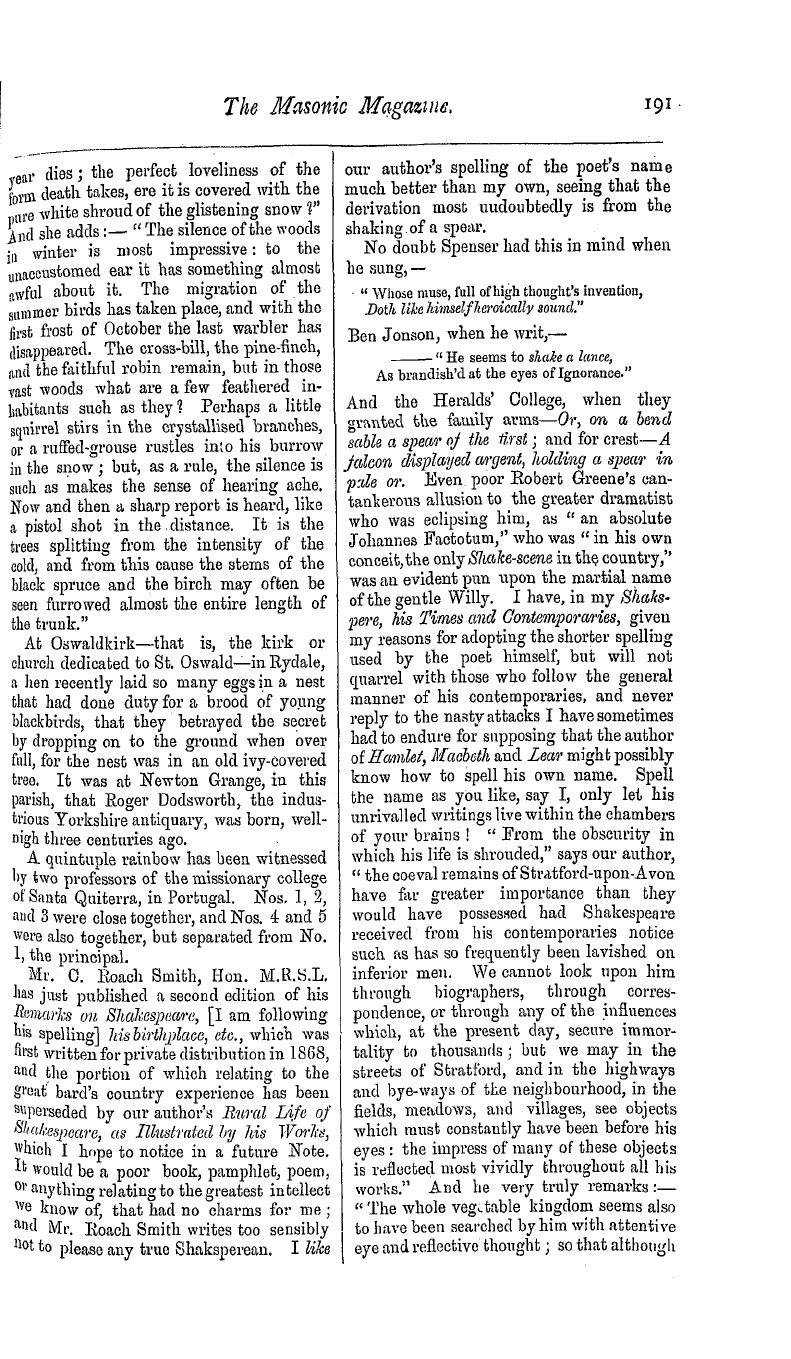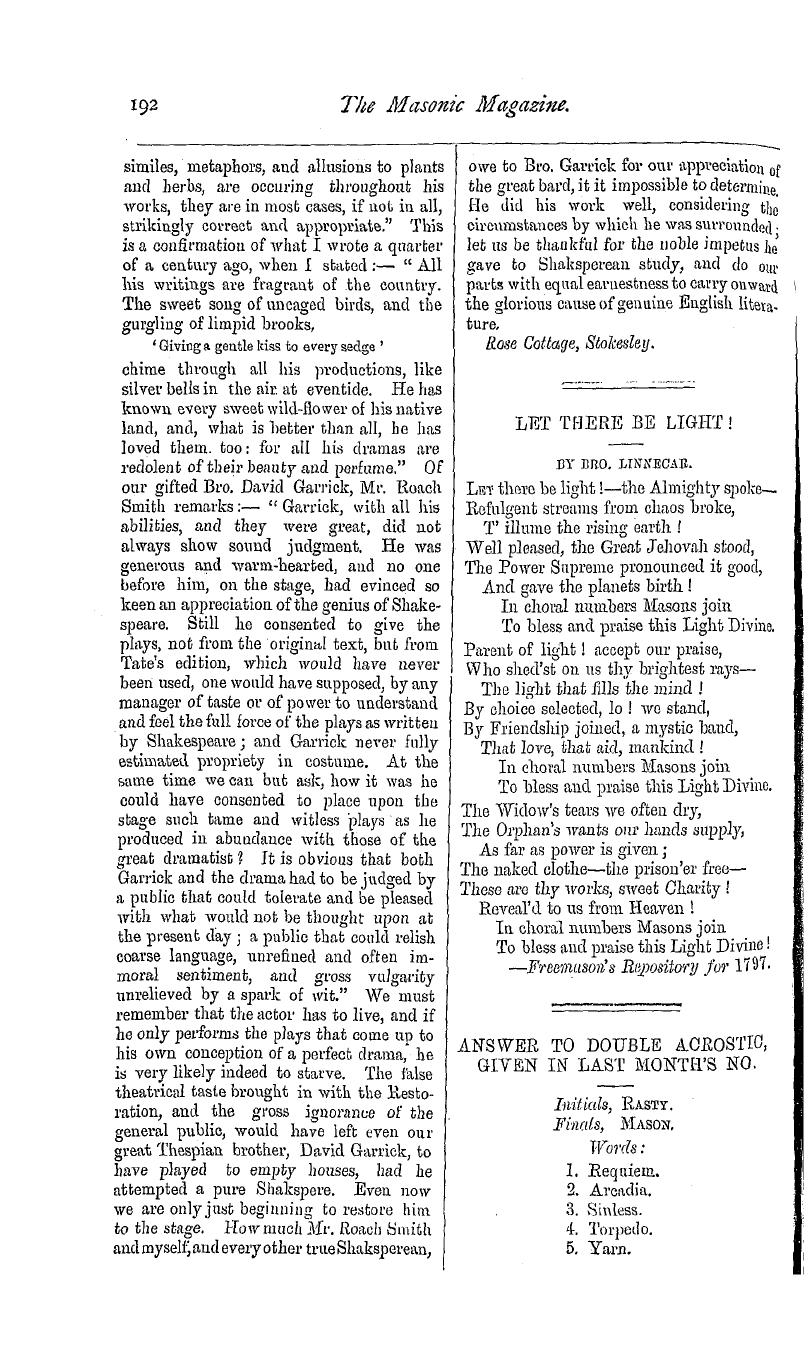-
Articles/Ads
Article Architectural Jottings. Page 1 of 3 →
Note: This text has been automatically extracted via Optical Character Recognition (OCR) software.
Architectural Jottings.
Architectural Jottings .
FOUR WELL-KNOWN ABBEYS . { Continued from page 118 . ) OF all the four Abbeys which we are describing , that of Dryburgh is much the most picturesque and beautiful for its
situation . It stands on a semicircular level space , round which the Tweed sweeps at the foot of wooded hills . As the visitor comes in sight of the ruins , it may be after a hot walk from St . Bos well ' s in a powerful afternoon ' s sun , and after a
morning at Melrose , he will probably sit on the wooden bench and contemplate the scene . Here , he may say to himself , is all the charm of solitude . Here one feels at home , with a pure early English building to look at ; here are lancet lights
with nook-shafts and dog-tooth , and a great south transept window of five lancet lights . Here all is seen intermingled with the fresh green of the beach and of the ash , and we have glimpses of ivy-clad ruins of some magnitudenot belonging to
, the church itself . For here , as we shall see , we have all the most important monastic buildings left , except the Church itself , a great part of which is gone .
Dryburgh is too far from the haunts of men to have served as a convenient quarry , or , by its entire demolition , to have afforded desirable space for building . Much , however , is gone for ever ; what remains , we will endeavour to describe . The east end of the choir is nearlall
y gone , but enough of it is left to show that the sanctuary has extended eastward beyond the ends of the choir-aisles , as at Melrose ( see below ) . The north aisle of the short choir , of one bay only , alone remains , forming a chapel which now
serves as the burial-place of Sir Walter Scott and of his family . The north transept also standing , and very short , has onl y one eastern chapel . All this fragment of choir and transept is very fine Earl y English Work ; whether it be really
° f a date subsequent to Edward the Second ' s burning , or whether it was built Previousl y , and survived that catastrophe , * e are not able positively to affirm . Of * he south transept little is left but its 3 outh end , rising above the top of the dormitory tbe roof of which has encroached
upon the lower part of its window of five lancet li ghts , which is so conspicuous a feature in all views of the Abbey . We have also the stone stairs leading to a semicircular-headed doorway to the dormitory , as at JVJ elrose . Of the nave very little is left but the foundations of the piers and
the west end , denuded of its facing-stones . The west door-way remains , a semicircular arch with filleted rolls and hollows containing square flowers , probably of the 14 or 15 century . In the south aisle lies the apex of the west gable just as it has
fallen , consisting of eight or nine courses of stone still adhering by the mortar . At the east end of the south aisle is a great semicircular doorway with deeply-cut mouldings and shafts capped by square abaci and transitional volutes , doubtless
belonging to the original structure . It leads by a flight of steps into the ., cloister quadrangle , which is on a much , lower level than the church . This enclosure , with the buildings connected with it , may now be described . In the north wall we observe the fine doorway j ust mentioned , a tall semicircular-headed doorway about the middle , and another near the west end ;
both these are blocked up . In the east wall , beginning by the great door to the church , is a remarkably fine example of a book closet , with grooves for shelves , rebate for folding doors , and marks of two hinges on either sicle . It has a segmental arched topquite plainso that
, , the doors would be flush with the wall . Its width is about six feet , its height four or five in the middle , and its depth about three feet , and the thickness of shelves 2 J- inches . The upper one has not come quite to the frontand has been for smaller
, books , ranged under the arch with the tallest in the middle . The space from the bottom of the closet to the lower shelf is 23 inches , and from this to the upper shelf 16 inches . Would that we could see the goodly tomes that once were here
preserved . We have been thus particular in the description of this book closet , because it is an arrangement regularly seen , and interesting as connected with the little studies of the monks ranged along the north walk of the cloister , so that they sat with their faces to the morning , noon , and evening lig ht . But we do not know of any other example in nearly so perfect a
Note: This text has been automatically extracted via Optical Character Recognition (OCR) software.
Architectural Jottings.
Architectural Jottings .
FOUR WELL-KNOWN ABBEYS . { Continued from page 118 . ) OF all the four Abbeys which we are describing , that of Dryburgh is much the most picturesque and beautiful for its
situation . It stands on a semicircular level space , round which the Tweed sweeps at the foot of wooded hills . As the visitor comes in sight of the ruins , it may be after a hot walk from St . Bos well ' s in a powerful afternoon ' s sun , and after a
morning at Melrose , he will probably sit on the wooden bench and contemplate the scene . Here , he may say to himself , is all the charm of solitude . Here one feels at home , with a pure early English building to look at ; here are lancet lights
with nook-shafts and dog-tooth , and a great south transept window of five lancet lights . Here all is seen intermingled with the fresh green of the beach and of the ash , and we have glimpses of ivy-clad ruins of some magnitudenot belonging to
, the church itself . For here , as we shall see , we have all the most important monastic buildings left , except the Church itself , a great part of which is gone .
Dryburgh is too far from the haunts of men to have served as a convenient quarry , or , by its entire demolition , to have afforded desirable space for building . Much , however , is gone for ever ; what remains , we will endeavour to describe . The east end of the choir is nearlall
y gone , but enough of it is left to show that the sanctuary has extended eastward beyond the ends of the choir-aisles , as at Melrose ( see below ) . The north aisle of the short choir , of one bay only , alone remains , forming a chapel which now
serves as the burial-place of Sir Walter Scott and of his family . The north transept also standing , and very short , has onl y one eastern chapel . All this fragment of choir and transept is very fine Earl y English Work ; whether it be really
° f a date subsequent to Edward the Second ' s burning , or whether it was built Previousl y , and survived that catastrophe , * e are not able positively to affirm . Of * he south transept little is left but its 3 outh end , rising above the top of the dormitory tbe roof of which has encroached
upon the lower part of its window of five lancet li ghts , which is so conspicuous a feature in all views of the Abbey . We have also the stone stairs leading to a semicircular-headed doorway to the dormitory , as at JVJ elrose . Of the nave very little is left but the foundations of the piers and
the west end , denuded of its facing-stones . The west door-way remains , a semicircular arch with filleted rolls and hollows containing square flowers , probably of the 14 or 15 century . In the south aisle lies the apex of the west gable just as it has
fallen , consisting of eight or nine courses of stone still adhering by the mortar . At the east end of the south aisle is a great semicircular doorway with deeply-cut mouldings and shafts capped by square abaci and transitional volutes , doubtless
belonging to the original structure . It leads by a flight of steps into the ., cloister quadrangle , which is on a much , lower level than the church . This enclosure , with the buildings connected with it , may now be described . In the north wall we observe the fine doorway j ust mentioned , a tall semicircular-headed doorway about the middle , and another near the west end ;
both these are blocked up . In the east wall , beginning by the great door to the church , is a remarkably fine example of a book closet , with grooves for shelves , rebate for folding doors , and marks of two hinges on either sicle . It has a segmental arched topquite plainso that
, , the doors would be flush with the wall . Its width is about six feet , its height four or five in the middle , and its depth about three feet , and the thickness of shelves 2 J- inches . The upper one has not come quite to the frontand has been for smaller
, books , ranged under the arch with the tallest in the middle . The space from the bottom of the closet to the lower shelf is 23 inches , and from this to the upper shelf 16 inches . Would that we could see the goodly tomes that once were here
preserved . We have been thus particular in the description of this book closet , because it is an arrangement regularly seen , and interesting as connected with the little studies of the monks ranged along the north walk of the cloister , so that they sat with their faces to the morning , noon , and evening lig ht . But we do not know of any other example in nearly so perfect a
















































